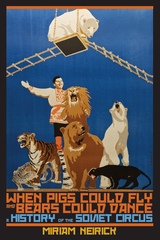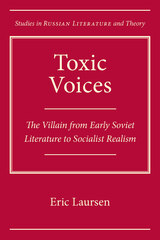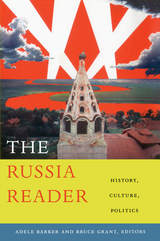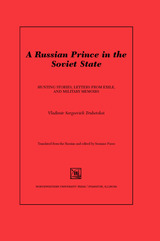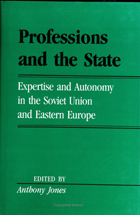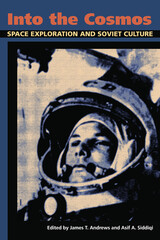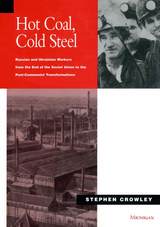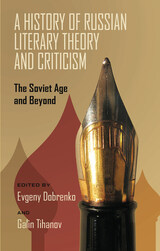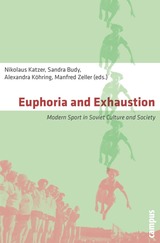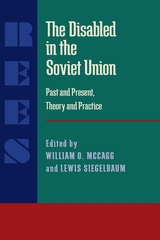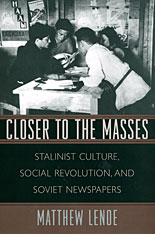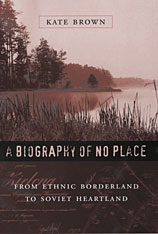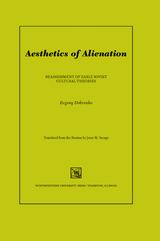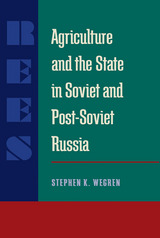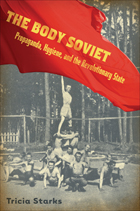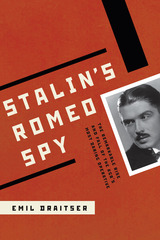What about Russia?Collection by Robby Desmond (16 items)There's plenty to learn about one of the largest countries in the world and the former center of the Soviet Union. I've picked a few that caught my eye. Includes the following tags:
Agriculture, Agriculture and state, Alienation, Autonomy, Circus, Coal miners, Communism and culture, Cosmos, Cultural & Social Aspects, Cultural pluralism, Culture Politics, Czechoslovakia, Dobrenko, Evgeny, End, Exhaustion, Exile, Expertise, Fall, Fusso, Susanne, Health and hygiene, Health Policy, Intelligence service, Into, Labor unions, Land reform, Masses, Modern Sport, Past, Place, Poland, Present, Regional Studies, Russia (Federation), Russian literature, Socialist Realism, Socialist realism, Socialist realism in literature, Sociological aspects, Soviet Union, Sports & Recreation, Starn, Orin, State, Ukraine, Villain, Villains in literature
See More
|
When Pigs Could Fly and Bears Could Dance
by Miriam Neirick
University of Wisconsin Press, 2012
For more than seven decades the circuses enjoyed tremendous popularity in the Soviet Union. How did the circus—an institution that dethroned figures of authority and refused any orderly narrative structure—become such a cultural mainstay in a state known for blunt and didactic messages? Miriam Neirick argues that the variety, flexibility, and indeterminacy of the modern circus accounted for its appeal not only to diverse viewers but also to the Soviet state. In a society where government-legitimating myths underwent periodic revision, the circus proved a supple medium of communication.
1
|
Toxic Voices
by Eric Laursen
Northwestern University Press, 2013
Satire and the fantastic, vital literary genres in the 1920s, are often thought to have fallen victim to the official adoption of socialist realism. Eric Laursen contends that these subversive genres did not just vanish or move underground. Instead, key strategies of each survive to sustain the villain of socialist realism. Laursen argues that the judgment of satire and the hesitation associated with the fantastic produce a narrative obsession with controlling the villain’s influence. In identifying a crucial connection between the questioning, subversive literature of the 1920s and the socialist realists, Laursen produces an insightful revision of Soviet literary history.
2
|
The Russia Reader
edited by Adele Marie Barker and Bruce Grant
series edited by Robin Kirk and Orin Starn Duke University Press, 2010
Letters recording the reactions of ordinary Russians to the Revolution as events unfolded in 1917, an account of the day-to-day scramble to make a living after the end of the Soviet Union, and excerpts from a sixteenth-century manual instructing elite Muscovites on proper household management—The Russia Reader brings these and many other selections together in this introduction to the history, culture, and politics of the world’s largest country, from the earliest written accounts of the Russian people to today. Conveying the texture of everyday life alongside experiences of epic historical events, the book is filled with the voices of men and women, rulers and revolutionaries, peasants, soldiers, literary figures, émigrés, journalists, and scholars. Most of the selections are by Russians, and thirty are translated into English for the first time. Illustrated with maps, paintings, photographs, posters, and cartoons, The Russia Reader incorporates song lyrics, jokes, anecdotes, and folktales, as well as poems, essays, and fiction by writers including Akhmatova, Dostoyevsky, Pushkin, and Tolstoi. Transcripts from the show trials of major Party figures and an account of how staff at the Lenin Library in Moscow were instructed to interact with foreigners are among the many selections based on personal memoirs and archival materials only recently made available to the public. From a tenth-century emissary’s description of his encounters in Kyivan Rus’, to a scientist’s recollections of her life in a new research city built from scratch in Siberia during the 1950s, to a novelist’s depiction of the decadence of the “New Russians” in the 2000s, The Russia Reader is an extraordinary introduction to a vast and varied country.
3
|
A Russian Prince in the Soviet State
by Vladimir Sergeevich Trubetskoi
edited by Susanne Fusso translated by Susanne Fusso Northwestern University Press, 2006
Of a noble and distinguished family disenfranchised by the Bolshevik revolution, Vladimir Trubetskoi (1892-1937) alone remmained in Russia, and suffered the consequences.His life and experiences are well documented in this remarkable volume, a selection of his writings that reflects his comfortable prewar existence and his post-revolutionary poverty, uncertainty, and displacement, all conveyed with humor and ironic detachment. Including selections from Trubetskoi's memoirs, his letters from exile in Uzbekistan, and his hunting stories, the chapters of this volume offer autobiographical narratives of the self, creative "reflections," ethnography, and, most of all, uniquely evocative and informative instances of history lived and recorded with quiet power and irrepressible character.
In his letters from exile, Trubetskoi describes his grim situation in Central Asia-how he snatched moments to write between mornings playing piano in a ballet studio and late nights in a restaurant band, struggling with the heat, the insect-borne illness, and the problems of a large, uprooted family. His memoirs of 1911-12, "Notes of a Cuirassier," are the culmination of his efforts and they convey in vivid detail the glittering prewar world of an elite Russian Guards regiment. These reminiscences as well as his stories offer a glimpse of what life was like for a citizen of Imperial Russia who tried to make a life for himself in the new Soviet state. Instructive, amusing, moving, Trubetskoi's stories are also an inspiring example of how a person of grace and true nobility meets large-scale social and political upheaval.
4
|
Professions And The State
by Anthony Jones
Temple University Press, 1991
Unlike autonomous professionals in Western industrialized democracies, professionals in a socialist, bureaucratic setting operate as employees of the state. The change in environment has important Implications not only for the practice of professions but also for the concept of professionalism itself. This collection of nine essays is the first to survey the major professions In the USSR, Czechoslovakia, and Poland. The contributors investigate the implications of professional experience in a socialist economy as well as relating changes in professional organization and power to reform movements in general and perestroika in particular.
5
|
Into the Cosmos
edited by James T. Andrews and Asif A. Siddiqi
University of Pittsburgh Press, 2011
The launch of the Sputnik satellite in October 1957 changed the course of human history. In the span of a few years, Soviets sent the first animal into space, the first man, and the first woman. These events were a direct challenge to the United States and the capitalist model that claimed ownership of scientific aspiration and achievement.
6
|
Hot Coal, Cold Steel
by Stephen Crowley
University of Michigan Press, 1997
Well after the disintegration of the Communist Party and the Soviet state--and through several years of economic collapse--industrial workers in almost every sector of the former Soviet Union have remained quiescent and the same ineffective and unpopular trade unions still hold a virtual monopoly on worker's representation. Why? While many argue that labor is a central variable in the development of economic and political systems, little is known about workers in the states of the former Soviet Union since the fall of Communism. In a comparative study of two groups of industrial workers--the coal miners and steelworkers--at the end of the Soviet era, Stephen Crowley sheds light on where these workers have been and where they are going.
Coal miners in the final years of the Soviet Union effectively organized and led strikes which supported the end of Communism, even though their heavy subsidies would be threatened by capitalism. Steel workers, in contrast, did not effectively organize and strike. This pattern has continued under the new governments, with the coal miners effectively organized and seeking protection from the worst consequences of marketization, while the steel workers remain weakly organized despite deteriorating economic conditions. Based on extensive on-site research including interviews with miners and steelworkers, labor leaders and plant managers, Crowley develops a detailed picture of the conditions under which workers organize. His findings have application beyond the conditions of post-Communist Russia and Ukraine to other societies undergoing fundamental change. This book will be of interest to sociologists and political scientists interested in the role of labor in transitional societies, the patterns of organization of labor, as well as area specialists. Stephen Crowley is Associate Professor of Political Science, Oberlin College.
7
|
A History of Russian Literary Theory and Criticism
edited by Evgeny Dobrenko and Galin Tihanov
University of Pittsburgh Press, 2013
This volume assembles the work of leading international scholars in a comprehensive history of Russian literary theory and criticism from 1917 to the post-Soviet age. By examining the dynamics of literary criticism and theory in three arenas—political, intellectual, and institutional—the authors capture the progression and structure of Russian literary criticism and its changing function and discourse.
8
|
Euphoria and Exhaustion
edited by Sandra Budy, Nikolaus Katzer, Alexandra Köhring and Manfred Zeller
Campus Verlag, 2010
The architects of the Soviet Union intended not merely to remake their society—they also had an ambitious plan to remake the citizenry physically, with the goal of perfecting the socialist ideal of man. As Euphoria and Exhaustionshows, the Soviet leadership used sport as one of the primary arenas in which to deploy and test their efforts to mechanize and perfect the human body, drawing on knowledge from physiology, biology, medicine, and hygiene. At the same time, however, such efforts, like any form of social control, could easily lead to discontent—and thus, the editors show, a study of changes in public attitude towards sport can offer insight into overall levels of integration, dissatisfaction, and social exhaustion in the Soviet Union.
9
|
The Disabled in the Soviet Union
edited by William O. McCagg and Lewis Siegelbaum
University of Pittsburgh Press, 1989
In topics ranging from industrial accident prevention before and during Stalin's industrialization drive to the long and complex history of the Soviet “science” called defectology, the essays in this collection chronicle the responses of the state and society to a variety of disabled groups and disabilities. Also included, in addition to the editors, are Julie Brown, Vera Dunham, David Joravsky, Janet Knox and Alex Kozulin, Stephen and Ethel Dunn, Bernice Madison, Paul Raymond, and Mark Field. This unusual and provocative collection brings to light a dimension of Soviet history and policy rarely explored.
10
|
Closer to the Masses
by Matthew Lenoe
Harvard University Press, 2004
In this provocative book, Matthew Lenoe traces the origins of Stalinist mass culture to newspaper journalism in the late 1920s. In examining the transformation of Soviet newspapers during the New Economic Policy and the First Five Year Plan, Lenoe tells a dramatic story of purges, political intrigues, and social upheaval.
11
|
A Biography of No Place
by Kate Brown
Harvard University Press, 2004
This is a biography of a borderland between Russia and Poland, a region where, in 1925, people identified as Poles, Germans, Jews, Ukrainians, and Russians lived side by side. Over the next three decades, this mosaic of cultures was modernized and homogenized out of existence by the ruling might of the Soviet Union, then Nazi Germany, and finally, Polish and Ukrainian nationalism. By the 1950s, this “no place” emerged as a Ukrainian heartland, and the fertile mix of peoples that defined the region was destroyed.
12
|
Aesthetics of Alienation
by Evgeny Dobrenko
translated by Jesse Savage Northwestern University Press, 2005
This provocative work takes issue with the idea that Socialist Realism was mainly the creation of party leaders and was imposed from above on the literati who lived and worked under the Soviet regime. Evgeny Dobrenko, a leading expert on Soviet literature, argues instead--and offers persuasive evidence--that the aesthetic theories underpinning Socialist Realism arose among the writers themselves, born of their proponents' desire for power in the realm of literary policymaking. Accordingly, Dobrenko closely considers the evolution of these theories, deciphering the power relations and social conditions that helped to shape them.
In chapters on Proletkult, RAPP, LEF, and Pereval, Dobrenko reexamines the theories generated by these major Marxist literary groupings of the early Soviet Union. He shows how each approached the problems of literature's response to the presumed social mandate of the young communist society, and how Socialist Realism emerged as a conglomerate of these earlier, revolutionary theories. With extensive and detailed reference to supporting testimony and documents, Dobrenko clearly demonstrates how Socialist Realism was created from within the revolutionary culture, and how this culture and its disciples fully participated in this creative process. His work represents a major breakthrough in our current understanding of the complex sources that contributed to early Soviet culture.
13
|
Agriculture and the State in Soviet and Post-Soviet Russia
by Stephen Wegren
University of Pittsburgh Press, 1998
A comprehensive, original, and innovative analysis of the social, economic, and political factors affecting contemporary Russian reform, the book is organized around the central question of the role of the state and its effect on the course of Russian agrarian reform. In the wake of the collapse of the USSR, contemporary conventional wisdom holds the the Russian state is “weak.” Stephen Wegren feels that the traditional approach to the weak/strong state suffers from measurement and circular logic problems, believing that the Russian state, thought weaker than in its Soviet past, is still relatively stronger than other actors. The state’s strength allows it to intervene in the rural sector in ways that other power contender cannot. Specifically, as a measure of state intervention, Wegren analyzes how the state has influenced urban-rural relations, rural-rural relations, and the nonstate (private) agricultural sector. Several dilemmas arose that have complicated successful agrarian reform as a result of the nature of state interventions, how reform policies were defined, and the incentives rhar arose from state-sponsored policies. During contemporary Russian agrarian reform, urban-rural differences have widened, marked by a deterioration in rural standards of living and increased alienation of rural political groups from urban alliances. At the same time, within the rural sector, reform failed to reverse rural egalitarianism. In addition, the nature of state interventions has undermined attempts to create a vibrant, productive private rural sector based on private farming. Wegren’s research is based upon extensive field work, interviews, archival documents, and published and unpublished source material conducted over a six-year period, and he demonstrates the link between agrarian reform and the success of overall reform in Russia. This learned and often controversial volume will interest political scientists, policy makers, and scholars and students of contemporary Russia.
14
|
The Body Soviet
by Tricia Starks
University of Wisconsin Press, 2008
In 1918 the People's Commissariat of Public Health began a quest to protect the health of all Soviet citizens, but health became more than a political platform or a tactical decision. The Soviets defined and categorized the world by interpreting political orthodoxy and citizenship in terms of hygiene. The assumed political, social, and cultural benefits of a regulated, healthy lifestyle informed the construction of Soviet institutions and identity. Cleanliness developed into a political statement that extended from domestic maintenance to leisure choices and revealed gender, ethnic, and class prejudices. Dirt denoted the past and poor politics; health and cleanliness signified mental acuity, political orthodoxy, and modernity. Health, though essential to the revolutionary vision and crucial to Soviet plans for utopia, has been neglected by traditional histories caught up in Cold War debates. The Body Soviet recovers this significant aspect of Soviet thought by providing a cross-disciplinary, comparative history of Soviet health programs that draws upon rich sources of health care propaganda, including posters, plays, museum displays, films, and mock trials. The analysis of propaganda makes The Body Soviet more than an institutional history; it is also an insightful critique of the ideologies of the body fabricated by health organizations. "A masterpiece that will thoroughly fascinate and delight readers. Starks's understanding of propaganda and hygiene in the early Soviet state is second to none. She tells the stories of Soviet efforts in this field with tremendous insight and ingenuity, providing a rich picture of Soviet life as it was actually lived."— Elizabeth Wood, author of From Baba to Comrade: Gender and Politics in Revolutionary Russia
15
|
Stalin's Romeo Spy
by Emil Draitser
foreword by Gary Kern Northwestern University Press, 2010
Sailor, painter, doctor, lawyer, polyglot, and writer, Dmitri Bystrolyotov (1901–75) led a life that might seem far-fetched for a spy novel, yet here the truth is stranger than fiction. The result of a thirty-five-year journey that started with a private meeting between the author and Bystrolyotov in 1973 Moscow and continued through the author’s subsequent research in international archives, Stalin’s Romeo Spy: The Remarkable Rise and Fall of the KGB’s Most Daring Operative pieces together a life lived in the shadows of the twentieth century’s biggest events. One of the “Great Illegals,” a team of outstanding Soviet spies operating in Western countries between the world wars, Bystrolyotov was mthe response to Sidney Reilly, the British prototype for James Bond. A dashing man, his modus operandi was the seduction of women—among them a French embassy employee, a German countess, the wife of a British official, and a Gestapo officer—which enabled Stalin to look into diplomatic pouches of many European countries. Risking his life, Bystrolyotov also stole military secrets from Nazi Germany and Fascist Italy. A man of extraordinary physical courage, he twice crossed the Sahara Desert and the jungles of Congo. But his success as a spy didn’t save him from Stalin’s purges, at the height of which he was arrested and tortured until he falsely confessed to selling out to the enemy. Sentenced to twenty years of hard labor in the Gulag, Bystrolyotov risked more severe punishment by documenting the regime’s crimes against humanity in unpublished and suppressed memoirs that rival those of Aleksandr Solzhenitsyn. The first full-length biography in any language, at once a real-life spy thriller, a drama of desire, and a prison memoir, Stalin’s Romeo Spy is the true account of a flawed yet extraordinary man.
16
|
| Click here to go to the beginning. | ||||||||||||||||
